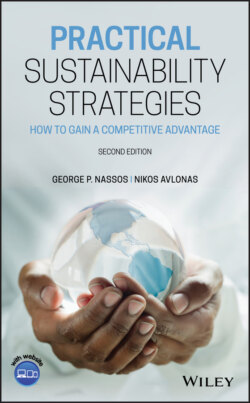Читать книгу Practical Sustainability Strategies - George P. Nassos - Страница 18
CONSERVATION OF WATER
ОглавлениеWater is a natural resource with a finite quantity. The amount of water on this planet 2000 years ago is the same as it is today, but the population during this time interval has gone from approximately 150 million to over 7 billion. But of all the water on the earth, how much is readily available to all of the living creatures? Figure 1.2 [12] provides a summary of the current situation.
The earth's surface is about 71% water; however, 97% of all the water on earth is saline. Of the remaining 3%, 68.7% is in the form of icecaps and glaciers, 30.1% is ground water, and 0.9% is in some other unavailable form. This leaves only 0.3% of the fresh water on earth available to us on the surface with 87% in lakes, 11% in swamps, and 2% in rivers. This means that only 0.1% of all the water on the earth is available for industrial, agricultural, and human use. And of these three general uses, 70% is for agricultural use, 20% for industrial use, and only 10% for human consumption. Going further with the calculations results in only 0.01% of all the water on the earth being consumed by humans, and as the population grows, that leaves less for everyone.
According to the United Nations, two-thirds of the world's population is projected to face water scarcity by 2025. In the United States, a federal report [12] by the General Accounting Office shows that 40 of the 50 states are anticipating water shortages by 2023. In 2008, the state of Georgia tried, unsuccessfully, to move the state's border north in order to claim part of the Tennessee River.
FIGURE 1.2 Distribution of earth's water.
The concern for this water shortage is partly due to the companies that require so much for their processes. It takes roughly 20 gal of water to make a pint of beer, about 130 gal of water to make a 2 l bottle of pop, and about 2000 gal of water to make a pair of Levi's stonewashed jeans. Why so much? For the pop, it includes the water used to grow the ingredients such as sugar cane. For the jeans, it includes the water used to grow, dye, and process the cotton.
Companies are now calculating the “water footprint” in order to manage better the water consumption. This is not dissimilar to the carbon footprint that organizations and individuals have been calculating for some years. The water-footprint concept was first developed in 2002 by A.Y. Hoekstra at the University of Twente in the Netherlands [13]. Following the water-footprint concept, studies were conducted to calculate the embedded, or virtual, water required for a product, which was then added to what is consumed directly. Embedded water includes everything from raising beef in South America, growing oranges in Spain, or growing cotton in Asia. By calculating the embedded water, you would learn that a typical hamburger takes 630 gal of water to produce. Most of the water is used to grow the grain to feed the cattle. This represents more than three times the amount the average American uses every day for drinking, bathing, washing dishes, and flushing toilets.
At first glance, these large numbers representing water footprints for certain products seem very alarming. However, they are not necessarily bad if there is available water and it is well managed. Since most of the water is used for crops, it becomes part of the water cycle where it is eventually evaporated or it is runoff. This water becomes temporarily unavailable for other uses, but that is not really a problem in an area that has plentiful water. If it doesn't return to the same aquifer or it returns as rainfall in another region, this could be a problem.
